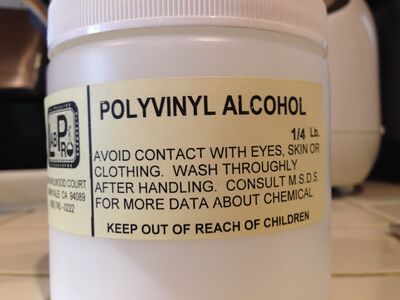In preparation for exploring Vincent Amendola's PVA/Guar Gum/J-Lube recipe , I mixed up a 10% PVA Solution using Polyvinyl Alcohol powder purchased in 2011 or so. I know nothing about the particular type of polyvinyl alcohol that this is. The chemistry supply store had no information to offer at the time of purchase. I've made 1% and 2% solutions in the past by simply sprinkling PVA powder into water that I was stirring by hand and then warm slightly and stirring some more.

Generic PVA from a local lab equipment store
Ingredients:
- 90 grams distilled water
- 10 grams polyvinyl alchohol powder
I sprinkled the PVA powder into room temperature distilled water while stirring by hand. When I was done sprinkling the powder, the solution was milky/chalky. I put the beaker in the microwave for 20 seconds to warm it. The solution became clear with a white sediment.
I stirred some more. The solution was somewhat milky. Repeated the warm then stir cycle a few times until the solution was clear. At that point it had a syrupy viscosity. It didn't turn out entirely transparent -- but there doesn't seem to be any sediment. It is translucent and perhaps trapped air is making it not completely transparent.
We'll see!
NOTES[]

PVA Glycerine Problem
Glycerine/Aqueous PVA Issue: In trying to mix up Vincent Amendola's PVA/GUAR/PEO Recipe, I ran into a problem. When this aqueous PVA solution is added directly to a largely glycerine solution, the PVA turns into a discrete rubbery mass distinct from the glycerine solution. I found that if I added some propylene glycol to the PVA solution before adding to the glycerine/guar slurry that this didn't happen. I added 10 grams of propylene glycol to 15 grams of 10% PVA solution. I suspect that Vincent doesn't run into this problem because the PVA product he uses has some isopropanol which probably also prevents the PVA some separating out.
